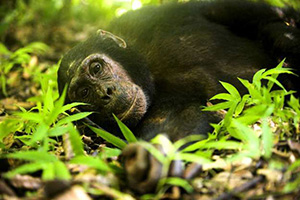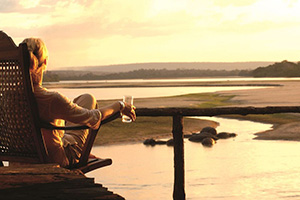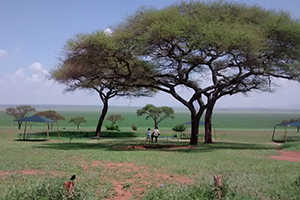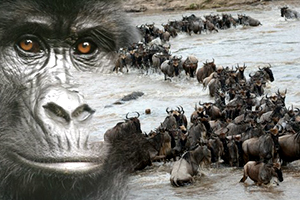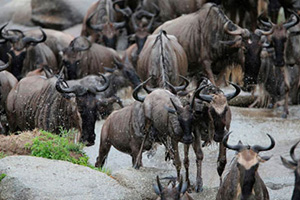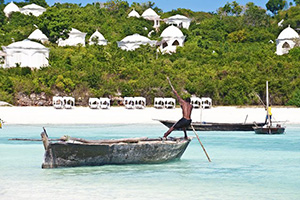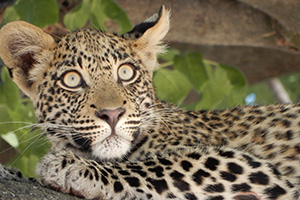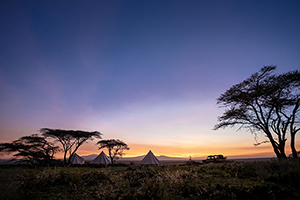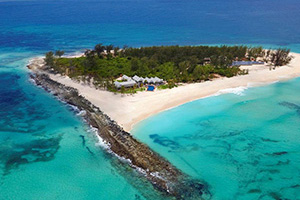Tanzania Safari Attractions
Serengeti National Park
The vast plains of Serengeti National Park host the infamous annual wildlife migration. True African adventure safaris, the savannahs permanent watering holes draw the greatest concentrations of wildebeest, zebra and gazelles on earth, followed by their predators. Encompassing an area of 1.5 million hectares, Serengeti National Park is without a doubt the best-known wildlife sanctuary in the world, unparalleled for its natural beauty and scenic value. The Serengeti gives you the sense of seeing the ends of the earth with the sun burnt savannah shimmering on the horizon. The rains give way to an endless green blanket of new growth and wildflowers. Rivers are lined with majestic Figs, Ebony & Acacia trees and endless termite mounds dot the landscape.
The Grumeti River is situated at the remote western corridor of Serengeti National Park and considered by many to be one of the prime viewing areas during the migration (typically between June & July). However, the area has an astounding year round concentration of animals like pride of lion, spotted hyena, cheetah, crocodile, hippo, Colobus monkeys, buffalo, zebra and Thomson's gazelle.
Ngorongoro Crater
A real African safari experience, the volcanic Ngorongoro Crater, located between the Serengeti and Lake Manyara, is the largest unbroken caldera in the world! Stunning views of scenic grandeur, the Ngorongoro Crater is one of the best places in Tanzania to view the rare black rhino, as well as prides of lion, zebra, wildebeest, leopard, cheetah, hyena, elephants, warthog, impala, buffalo, hartebeest, eland and a variety of water birds around the lake on the crater floor.
Lake Manyara
A short distance from Arusha, Lake Manyara National Park is usually the first stop on a multi-destination Tanzania safari. This beautiful park is at the base of the Great Rift Valley escarpment. Comprised of forest, woodland, grasslands, and swamps, Lake Manyara is the perfect habitat for gazelles, impala, buffalo, wildebeest, the famous tree climbing lion, hyena, baboon, giraffe, hippos and a great number of smaller mammals. Lake Manyara is also a spectacular place for special interest safaris, like bird watching, with over 350 species of bird, storks and hundreds of flamingoes.
Tarangire National Park
Always an African adventure safari experience, Tarangire National Park has a particularly dense wildlife population between June - October. During the migration from the Maasai Mara, many of the migratory wildlife species come back to the permanent waters of Tarangire River. Large herds of eland, lesser kudu, Kongoni, impala, Zebra, gazelles, buffalo, wildebeest, leopard, elephant and rhino congregate until the onset of the rains when they migrate again to good grazing areas.
Home to thousands of elephant, Tarangire National Park is symbolized by the vast number of Baobab tree, growing in open acacia woodland. Tarangire is an ornithologist's paradise rich in birds of prey and an incredible diversity of avifauna.
Arusha National Park
The starting place for many a Tanzania African safari vacation, Arusha National Park, lies near the main town of Arusha. Aside from the abundance of wildlife, fauna and flora there are three spectacular features: momella lakes, Meru Crater, and the Ngurdoto Crater. Both Mount Kilimanjaro and Mount Meru can be seen from the park when the sky is clear.
Selous Game Reserve
The largest game reserve in Africa, 4 times the size of the Serengeti, Selous Game Reserve is a diverse landscape from hot volcanic springs, sporadic lakes and channels from the Great Rhaha & Rufiji rivers. Most famous for it's elephant, hippo & rhino, the park has a broad range of wildlife with the largest population in Africa of Nyasaland gnu, brindled gnu, hartebeest, Greater Kudu, sable antelope, eland, reedbuck, bushbuck, waterbuck, warthog, zebras, giraffe and wildebeest. Also in abundance are lion, leopard, the spotted hyena and hunting dog, although cheetah sightings are rare.
This is not your typical African safari ~ you can also take a cable car across Stieglers Gorge, participate in special interest Africa safaris like: Photography, walking safaris and bird watching ~ A birdwatchers paradise, there are over 350 species of bird! Nearby you can go fishing for Tiger Fish and Vandu (in the rivers of the Kilombero Game Controlled Area to the west of the reserve).
Mount Kilimanjaro
Mount Kilimanjaro, at the north/eastern tip of Tanzania is only for the physically fit and adventurous traveler. If that's you, a climb of Mount Kilimanjaro is a must! With a very broad range of climates the trek will take you through the mists of equatorial jungle to reach the snow capped peaks and breathtaking views from the summit. The upward track winds through forests that vary constantly with the altitude and finally opens out into sweeping moorland below rocky, snow covered Kibo plateau. It has 3 volcanic centers; Shira, Kibo, and Mawenzi adding to the splendor and diversity of this true African adventure safari!
Mt. Kilimanjaro can be climbed at any time during the year. However, many feel the best months for climbing are January, February, September and October, being the warmest months and fairly clear of clouds. April/May and November/December are considered the rainy seasons. The Christmas Holiday season is usually fully booked a year in advance. We can arrange multi-day climbs from Moshi or Arusha.
Ruaha National Park
Ruaha is one of Tanzania's least accessible parks, with the Great Ruaha River meandering through its borders ~ a remote bastion of spectacular wilderness, undisturbed wildlife, and breathtaking scenery that appears totally untouched. It remains one of the most exciting game reserves with an authentic African safari feel.
Ruaha is interesting as it represents a transition zone where eastern and southern African species of fauna and flora overlap ~ Elephant, buffalo, hippos, striped hyena, crocodiles, lion, cheetah, leopard, wild dog and lots of antelope ~ greater & lesser Kudu, roan and sable are not found together in any other park in Tanzania. Ruaha is another birdwatcher's paradise with more than 400 species of bird recorded ~ some not found in northern Tanzania. The park is open from May thru November, with the best being July to November.






